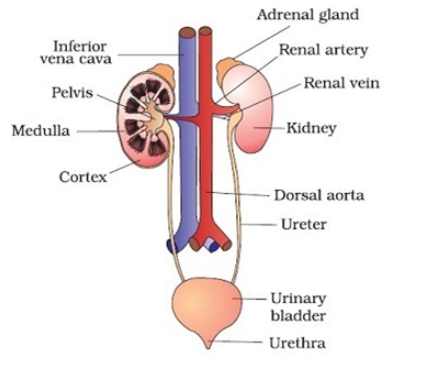
What is the function of kidneys in excretion? Explain with the help of a diagram.
Answer
494.1k+ views
Hint: Kidneys are two dark red, bean shaped organs situated at the back of the abdomen, one on either side of the vertebral column. The right kidney is lying slightly lower than the left. It mainly takes part in elimination of body wastes and to regulate the composition of body fluids and tissues.
Complete answer:
The human excretory system comprises a pair of kidneys, a pair of ureters, a urinary bladder and a urethra. The main route by which the body eliminates substances is through the kidneys. The primary function of the kidney is the elimination of waste from the bloodstream by production of urine. Kidneys also perform several homeostatic functions such as:-
Maintaining volume of extracellular fluid
Maintaining ionic balance in extracellular fluid
Maintaining pH and osmolarity of the extracellular fluid.
Excreting toxic metabolic by-products such as ammonia, urea, and uric acid.
The structural and functional unit of the kidney is the nephron. Each kidney comprises about one million (ten lakhs) of nephrons. Each nephron consists of Malpighian corpuscle and renal tubule. Malpighian corpuscle or renal corpuscle comprises glomerulus and Bowman’s capsule that take part in filtration of blood. Renal tubule consists of proximal convoluted tubule, loop of Henle and distal convoluted tubule that take part in selective reabsorption and tubular secretion. Once all these processes are completed, the needed materials go back into the bloodstream, and unneeded materials become urine and are gotten rid of.

Note: The kidneys are considered as the most vital organs of the human body. The kidneys produce urine by eliminating toxic wastes and excess water from the body. Urine formed in each kidney passes through the ureter, flows into the bladder before finally being excreted through the urethra.
Complete answer:
The human excretory system comprises a pair of kidneys, a pair of ureters, a urinary bladder and a urethra. The main route by which the body eliminates substances is through the kidneys. The primary function of the kidney is the elimination of waste from the bloodstream by production of urine. Kidneys also perform several homeostatic functions such as:-
Maintaining volume of extracellular fluid
Maintaining ionic balance in extracellular fluid
Maintaining pH and osmolarity of the extracellular fluid.
Excreting toxic metabolic by-products such as ammonia, urea, and uric acid.
The structural and functional unit of the kidney is the nephron. Each kidney comprises about one million (ten lakhs) of nephrons. Each nephron consists of Malpighian corpuscle and renal tubule. Malpighian corpuscle or renal corpuscle comprises glomerulus and Bowman’s capsule that take part in filtration of blood. Renal tubule consists of proximal convoluted tubule, loop of Henle and distal convoluted tubule that take part in selective reabsorption and tubular secretion. Once all these processes are completed, the needed materials go back into the bloodstream, and unneeded materials become urine and are gotten rid of.

Note: The kidneys are considered as the most vital organs of the human body. The kidneys produce urine by eliminating toxic wastes and excess water from the body. Urine formed in each kidney passes through the ureter, flows into the bladder before finally being excreted through the urethra.
Recently Updated Pages
The correct geometry and hybridization for XeF4 are class 11 chemistry CBSE

Water softening by Clarks process uses ACalcium bicarbonate class 11 chemistry CBSE

With reference to graphite and diamond which of the class 11 chemistry CBSE

A certain household has consumed 250 units of energy class 11 physics CBSE

The lightest metal known is A beryllium B lithium C class 11 chemistry CBSE

What is the formula mass of the iodine molecule class 11 chemistry CBSE

Trending doubts
State the laws of reflection of light

One Metric ton is equal to kg A 10000 B 1000 C 100 class 11 physics CBSE

Difference Between Prokaryotic Cells and Eukaryotic Cells

What is the modal class for the following table given class 11 maths CBSE

How do I convert ms to kmh Give an example class 11 physics CBSE

Give an example of a solid solution in which the solute class 11 chemistry CBSE




